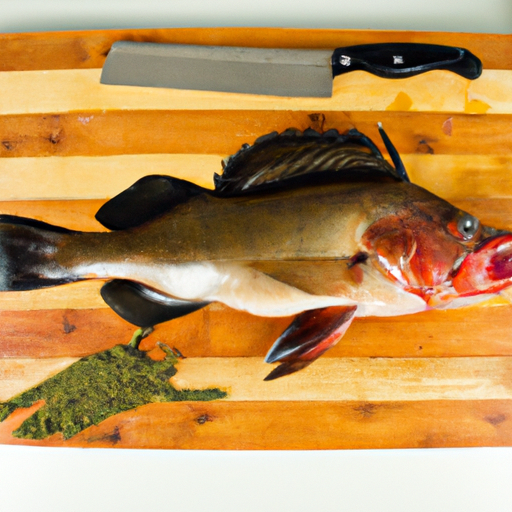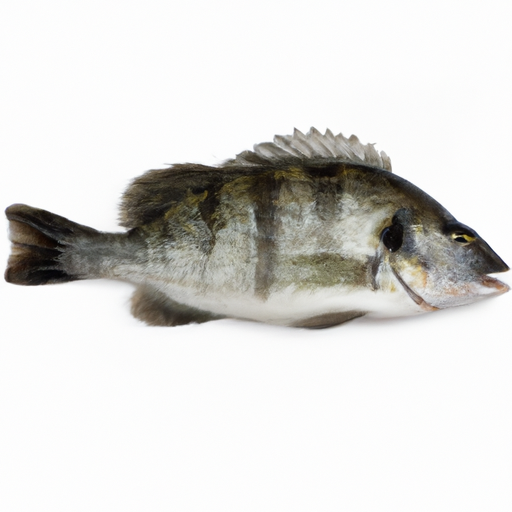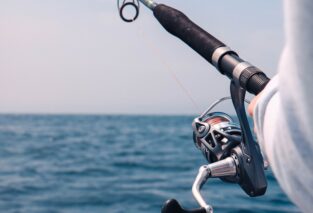In “How To Clean And Prepare Your Catch: A Guide For Beginners,” you will discover the essential tips and techniques to turn your freshly caught fish into a delicious meal. Whether you’re a novice angler or have just recently taken up fishing as a hobby, this comprehensive guide will walk you through the step-by-step process of cleaning and preparing your catch. From choosing the right tools to properly filleting the fish, this article will equip you with the knowledge and confidence to tackle the task with ease. Say goodbye to store-bought fillets and hello to a mouthwatering dish made from your very own catch!

Choosing the Right Equipment
When it comes to cleaning and preparing your catch, having the right equipment is essential. Not only will the proper tools make the process easier, but they will also ensure that you achieve the best possible results. There are three key aspects to consider when selecting your equipment: choosing the appropriate knife, gloving up for hygiene, and getting the essential utensils.
Selecting the Appropriate Knife
One of the most crucial tools you’ll need for cleaning and preparing your catch is a good knife. It’s important to choose a knife that is sharp, durable, and suitable for the type of fish you’ll be cleaning. For small to medium-sized fish, a flexible fillet knife is ideal, as it allows for precision and ease of use. For larger fish, a sturdy boning knife is recommended to tackle the tougher scales and bones. Regardless of the type of knife you choose, make sure it feels comfortable in your hand and is easy to grip.
Gloving Up for Hygiene
Maintaining proper hygiene is essential when handling fish and seafood. Wearing gloves not only protects your hands from any potential cuts or injuries but also helps prevent cross-contamination. Choose gloves that are food-safe and disposable, as they are convenient and hygienic. By wearing gloves, you can ensure that your catch remains fresh and free from any harmful bacteria.
Getting the Essential Utensils
In addition to a good knife and gloves, there are a few other essential utensils that will greatly assist you in the cleaning and preparation process. A cutting board with a channel to catch any juices is a must-have, as it will help keep your workspace clean. A pair of fish pliers or tweezers will come in handy for removing any remaining bones from the fillets. Additionally, having a sharpening stone or honing steel will allow you to maintain the sharpness of your knife, ensuring efficient and precise cuts every time.
The Cleaning Process
Once you have gathered all your equipment, it’s time to dive into the cleaning process. Cleaning a fish involves several steps, including rinsing in cold water, removing the scales, gutting, deskinning fillets, and removing bones.
Rinsing the Catch in Cold Water
After catching your fish, the first step in the cleaning process is to rinse it in cold water. This is important to remove any dirt, sand, or debris that may be clinging to the surface. Rinse the fish thoroughly, making sure to pay attention to all the crevices and underside. Cold water helps maintain the freshness of the fish and ensures that it is ready for further cleaning.
Removing the Scales
Scales are an integral part of a fish’s protective layer, but they are not particularly palatable when it comes to cooking and eating. The next step is to remove these scales to make the fish more enjoyable to consume. Using a fish scaler or the back of a knife, gently scrape against the direction of the scales. Work from the tail towards the head, doing so on both sides of the fish until all the scales are removed. Be sure to rinse the fish under cold water again to remove any loose scales.
Gutting the Fish
Gutting the fish is an essential step in the cleaning process, as it removes the internal organs and creates a clean canvas for further preparation. To gut the fish, make a small incision along the belly from the anal vent to the base of the gills. Hold the fish firmly and carefully remove the entrails, being mindful not to puncture any organs. Rinse the cavity thoroughly under cold water to ensure it is clean.
Deskinning the Fillets
Deskinning the fillets is necessary if you prefer to have skinless fish for your recipes. To do this, place the fillet skin-side down on the cutting board. Hold the tail end firmly and make a small cut between the flesh and the skin. Gently slide your knife between the skin and the flesh, applying light pressure. Work your way along the length of the fillet, ensuring all the skin is removed. Rinse the fillet under cold water to remove any skin fragments.
Removing Bones from Fillets
To remove any remaining bones from the fillets, you can use a pair of fish pliers or tweezers. Grip the end of the bone firmly with the pliers or tweezers and gently pull it out in the same direction as the bone. Take your time and ensure you remove all the small pin bones for a pleasant eating experience. Once the bones are removed, rinse the fillets under cold water one final time to remove any debris.
Cleaning Other Seafood
When it comes to cleaning seafood other than fish, specific techniques and precautions need to be applied. Let’s explore how to properly prepare oysters and crustaceans.
Shucking Oysters
If you’re lucky enough to have fresh oysters, shucking them can be a rewarding and delicious experience. Start by holding the oyster with a towel to protect your hand. Insert an oyster knife into the hinge, applying pressure in a twisting motion until the shell cracks open. Slide the knife along the top shell to release the oyster, being careful not to spill any of the precious brine. Rinse the oyster under cold water to remove any shell fragments and enjoy them raw or cooked to your preference.
Removing Shells from Crustaceans
Crustaceans such as crabs and lobsters are a treat to eat, but the process of removing their shells can seem intimidating. Start by grabbing the crustacean firmly and twisting off the claws and legs. Next, detach the main body from the tail by gently pulling them apart. To remove the shells, make an incision down the back of the body and carefully peel away the shell. Remove the digestive tract and rinse the crustacean under cold water to ensure it is clean.
Handling and Preparing Shellfish
Shellfish like clams, mussels, scallops, and shrimp require specific cleaning methods to remove any dirt or sand. Let’s dive into the details of cleaning and preparing these delightful seafood options.
Cleaning Clams and Mussels
Clams and mussels should be soaked in cold water for at least 20 minutes before cleaning to allow them to expel any sand or grit. After soaking, scrub the shells with a brush under running water to remove any debris. To ensure they are safe to eat, tap any open shells, and discard those that do not close after being tapped. Rinse the cleaned clams and mussels under cold water once more before cooking.
Preparing Scallops and Shrimp
Scallops and shrimp are versatile seafood options that can be enjoyed in various recipes. To clean scallops, start by removing the small side muscle attached to the scallop. Rinse them under cold water and pat them dry before cooking. For shrimp, start by removing the shell by gently pulling it away from the body. Devein the shrimp by making a shallow cut along its back and removing the dark vein. Rinse the cleaned scallops and shrimp under cold water to ensure they are free from any remaining grit or debris.

Cleaning Freshwater Fish
Freshwater fish, such as trout and bass, require specific cleaning techniques to ensure their flavors shine through. Let’s explore how to prepare these fish for your culinary endeavors.
Preparing Trout
Trout is a popular fish among anglers and food enthusiasts alike. Cleaning trout begins by removing the scales, which can be accomplished using a fish scaler or the back of a knife. Once the scales are removed, make a small incision along the belly from the anal vent to near the gills. Carefully remove the entrails, ensuring not to puncture any organs. Rinse the trout under cold water, and it’s ready to be cooked whole or filleted according to your preference.
Processing Bass
Bass is a delicious freshwater fish that can be prepared in various ways. Start by removing the scales using a fish scaler or the back of a knife. Once the scales are removed, make a small incision along the belly, similar to the trout cleaning process. Carefully remove the entrails, ensuring not to puncture any organs. Rinse the bass under cold water, and it’s ready to be cooked whole or filleted as desired.
Cleaning Saltwater Fish
Saltwater fish provide a unique flavor profile that is highly sought after by seafood lovers. Let’s explore the cleaning techniques for flounder, snapper, and grouper, three popular saltwater fish.
Cleaning Flounder
Flounder is a flatfish that requires specific cleaning techniques to maximize its flavor. Start by removing the scales using a fish scaler or the back of a knife. Once the scales are removed, make a small incision along the belly from the anal vent to near the gills. Carefully remove the entrails, ensuring not to puncture any organs. Rinse the flounder under cold water and it’s ready to be cooked whole or filleted based on your preference.
Filleting Snapper
Snapper is a prized saltwater fish known for its flavorful meat. To fillet a snapper, start by removing the scales using a fish scaler or the back of a knife. Once the scales are removed, make a small incision behind the head and run the knife along the top of the fish towards the tail. Gently separate the fillet from the backbone by cutting along the rib bones. Repeat the process on the other side. Rinse the fillets under cold water to remove any scales or debris, and they are ready to be cooked.
Preparing Grouper
Grouper is a popular saltwater fish with a mild, yet distinct flavor. The cleaning process for grouper is similar to that of other saltwater fish. Start by removing the scales using a fish scaler or the back of a knife. Once the scales are removed, make a small incision along the belly from the anal vent to near the gills. Carefully remove the entrails, ensuring not to puncture any organs. Rinse the grouper under cold water and it’s ready to be cooked whole or filleted as desired.

Storing Your Catch
Once you have cleaned and prepared your catch, proper storage is crucial to maintain its quality and freshness. Let’s explore the different storage methods and packaging techniques for freezing.
Choosing the Right Storage Method
The storage method you choose depends on the timeline for consuming your catch. If you plan to enjoy your fish within a day or two, storing it in a refrigerator is ideal. Place your cleaned and prepared fish in an airtight container or wrap it tightly in plastic wrap or aluminum foil to prevent any air exposure. For longer-term storage, freezing is the way to go.
Packaging for Freezing
To ensure your catch stays fresh in the freezer, proper packaging is key. Start by individually wrapping each fish fillet or portion in plastic wrap. This will prevent any moisture loss and protect against freezer burn. Place the wrapped fish portions in a freezer bag, removing as much air as possible before sealing. Label the bag with the date and type of fish to keep track. For extra protection, you can also double-bag the fish or use a vacuum sealer. Properly packaged, your fish can safely remain in the freezer for up to several months.
Cooking Tips and Recipes
Now that you have successfully cleaned and prepared your catch, it’s time to unleash your culinary creativity. Here are some cooking tips and recipes to help you make the most of your freshly caught fish and seafood.
Marinades for Grilling
Grilling fish and seafood can infuse delightful flavors and textures. Marinating your catch before grilling is a great way to enhance its taste. For a simple marinade, combine olive oil, lemon juice, garlic, and your choice of herbs and spices. Let the fish or seafood marinate for at least 30 minutes before grilling. Experiment with different combinations of marinades to create your signature flavor.
Baking Fish with Herbs
Baking fish with herbs is a classic method that brings out the natural flavors of the fish. Start by preheating your oven to the desired temperature. Place the cleaned and seasoned fish fillets on a baking sheet lined with parchment paper or aluminum foil. Top the fillets with fresh herbs such as dill, parsley, or thyme, along with a drizzle of olive oil. Bake the fish in the preheated oven until it is cooked through and flakes easily with a fork. Serve with a squeeze of lemon for a refreshing touch.
Pan-Frying Techniques
Pan-frying fish is a quick and delicious way to prepare your catch. Start by seasoning the cleaned fish fillets with salt, pepper, and any additional flavorings of your choice. Heat a skillet or frying pan over medium-high heat and add a small amount of oil or butter. Once the oil is hot, place the seasoned fillets in the pan and cook them for a few minutes on each side until they are golden brown and cooked through. Serve your pan-fried fish with a side of vegetables or a fresh salad.

Safety Tips and Hygiene
When it comes to handling fish and seafood, safety and hygiene should always be a priority. Here are some essential tips to ensure a safe and hygienic cleaning and preparation process.
Avoiding Cross-Contamination
Cross-contamination can occur when raw fish or seafood comes into contact with other foods or surfaces that will be consumed raw or uncooked. To avoid cross-contamination, be sure to thoroughly clean and sanitize any utensils, cutting boards, and surfaces that come into contact with raw fish or seafood. It’s also important to wash your hands thoroughly before and after handling raw fish to prevent the spread of bacteria.
Proper Waste Disposal
Proper disposal of fish waste is crucial to maintain a clean and sanitary environment. To dispose of fish waste, double-check any local regulations or guidelines for your area. In general, it is recommended to wrap fish waste tightly in a plastic bag and place it in a sealed garbage can. This prevents any odors or attracting unwanted pests.
Preventing Fish Odor
Fish odor can be strong and pervasive, but there are ways to minimize it during the cleaning and preparation process. One effective method is to clean your tools and utensils immediately after use with hot, soapy water to remove any lingering fish particles. Additionally, lemon juice, vinegar, or baking soda can be used to neutralize fish odor on your hands and cutting surfaces. Proper ventilation in your workspace can also help dissipate any lingering fish odor.
Conclusion
Cleaning and preparing your catch can be a rewarding experience for beginners and seasoned anglers alike. By selecting the right equipment, following the proper cleaning techniques, and taking necessary safety precautions, you can ensure the best results and enjoy delicious seafood dishes. Whether you’re grilling, baking, or pan-frying your freshly cleaned fish, let your culinary creativity shine and savor the flavors of your hard-earned catch.






